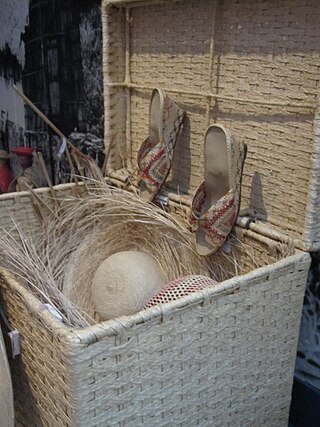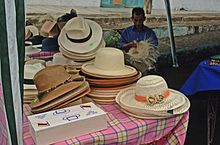
Weaving is a method of textile production in which two distinct sets of yarns or threads are interlaced at right angles to form a fabric or cloth. Other methods are knitting, crocheting, felting, and braiding or plaiting. The longitudinal threads are called the warp and the lateral threads are the weft, woof, or filling. The method in which these threads are interwoven affects the characteristics of the cloth. Cloth is usually woven on a loom, a device that holds the warp threads in place while filling threads are woven through them. A fabric band that meets this definition of cloth can also be made using other methods, including tablet weaving, back strap loom, or other techniques that can be done without looms.

A carpet is a textile floor covering typically consisting of an upper layer of pile attached to a backing. The pile was traditionally made from wool, but since the 20th century synthetic fibers such as polypropylene, nylon, or polyester have often been used, as these fibers are less expensive than wool. The pile usually consists of twisted tufts that are typically heat-treated to maintain their structure. The term carpet is often used in a similar context to the term rug, but rugs are typically considered to be smaller than a room and not attached to the floor.

A basket is a container that is traditionally constructed from stiff fibers, and can be made from a range of materials, including wood splints, runners, and cane. While most baskets are made from plant materials, other materials such as horsehair, baleen, or metal wire can be used. Baskets are generally woven by hand. Some baskets are fitted with a lid, while others are left open on top.

A boater is a semi-formal summer hat for men, which was popularised in the late 19th century and early 20th century.

A straw hat is a wide-brimmed hat woven out of straw or straw-like synthetic materials. Straw hats are a type of sun hat designed to shade the head and face from direct sunlight, but are also used in fashion as a decorative element or a uniform.

Cuenca, officially Santa Ana de los Ríos de Cuenca, is an Ecuadorian city, head of the canton of the same name and capital of the province of Azuay, as well as its largest and most populated city. It is crossed by the Tomebamba, Tarqui, Yanuncay and Machángara rivers, in the south-central inter-Andean region of Ecuador, in the Paute river basin, at an altitude of 2,538 meters above sea level and with a temperate Andean climate averaging 16.3 °C.
Ecuador is a multicultural and multiethnic nation, with the majority of its population is descended from a mixture of both European and Amerindian ancestry. The other 10% of Ecuador's population originate east of the Atlantic Ocean, predominantly from Spain, Italy, Lebanon, France and Germany. Around the Esmeraldas and Chota regions, the African influence would be strong among the small population of Afro-Ecuadorians that account for no more than 10%. Close to 80% of Ecuadorians are Roman Catholic, although the indigenous population blend Christian beliefs with ancient indigenous customs. The racial makeup of Ecuador is 70% mestizo, 7% Amerindian, 12% White, and 11% Black.

Manta, also known as San Pablo de Manta, is a city in Ecuador, cantonal head of the Manta Canton, as well as the largest and most populated city in the Manabí Province. It is the seventh most populous in the country. Manta has existed since Pre-Columbian times. It was a trading post for the Manta, also known as Manteños.

Straw plaiting is a method of manufacturing textiles by braiding straw and the industry that surrounds the craft of producing these straw manufactures. Straw is plaited to produce products including straw hats and ornaments, and the process is undertaken in a number of locations worldwide.

Montecristi is a town in the Manabí province of Ecuador and the capital of Montecristi Canton.

Gualaceo Canton, nicknamed “El Jardin del Azuay”, is a canton in the sierra region of Ecuador in the Azuay Province. The seat of the canton Gualaceo, is located 35 km east from the city of Cuenca and is one of the biggest cities in Azuay.

Ecuadorian Americans are Americans of full or partial Ecuadorian ancestry. Ecuadorian Americans are the 9th largest Latin American group in the United States. Ecuadorian Americans are usually of Mestizo, Amerindian or Afro-Ecuadorian background.

Romanian dress refers to the traditional clothing worn by Romanians, who live primarily in Romania and Moldova, with smaller communities in Ukraine and Serbia. Today, the vast majority of Romanians wear modern-style dress on most occasions, and the garments described here largely fell out of use during the 20th century. However, they can still be seen in more remote areas, on special occasions, and at ethnographic and folk events. Each historical region has its own specific variety of costumes.
Paccha is a town and parish in Cuenca Canton, Azuay Province, Ecuador. The parish covers an area of 25.6 km2 and according to the 2001 Ecuadorian census it had a population total of 5,311.

The Manteño-Huancavilca culture were one of the last pre-Columbian cultures in modern-day Ecuador, active from 850 to 1600 CE. It encompasses the area of the earlier Valdivia culture.
Federico Eulogio Malo Andrade was an Ecuadorian entrepreneur and financier born in Cuenca, Ecuador
Andrés Uc Dzul (1910–2004) was a Mexican artisan specializing in the creation of palm hats, especially Panama hats. His work was in great demand in the first half of the 20th century, and he was later recognized as a “grand master”.
Ecua-Andino Hats is an Ecuadorian company founded in 1985 by Alejandro Lecaro and Édgar Sánchez. The brand is dedicated to the production and exportation of Panama hats. It is one of the most important companies producing finished Panama hats in Ecuador.

Montubio is the term used to describe the mestizo people of the countryside of coastal Ecuador. The Montubio make up 7.4% of the country's population and were recognized as a distinct ethnicity by the government in the spring of 2001 after protests that included protracted hunger strikes. The Council for the Development of the Montubio People of the Ecuadorian Coast and Subtropical Zones of the Littoral Region (CODEPMOC) was granted official status and government funding.

The buntal hat is a traditional straw hat from the Philippines woven from fibers extracted from the petioles of buri palm leaves. It is traditionally worn by farmers working in the fields and was a major export of the Philippines in the first half of the 20th century. It can also be paired with semi-formal barong tagalog as well as informal attire. Its main centers of production are Baliwag, Bulacan, and (historically) Sariaya and Tayabas in Quezon Province. Buntal hats produced in Baliwag are also sometimes known as balibuntal hats, and are regarded as superior in quality to other types of buntal hats.






















